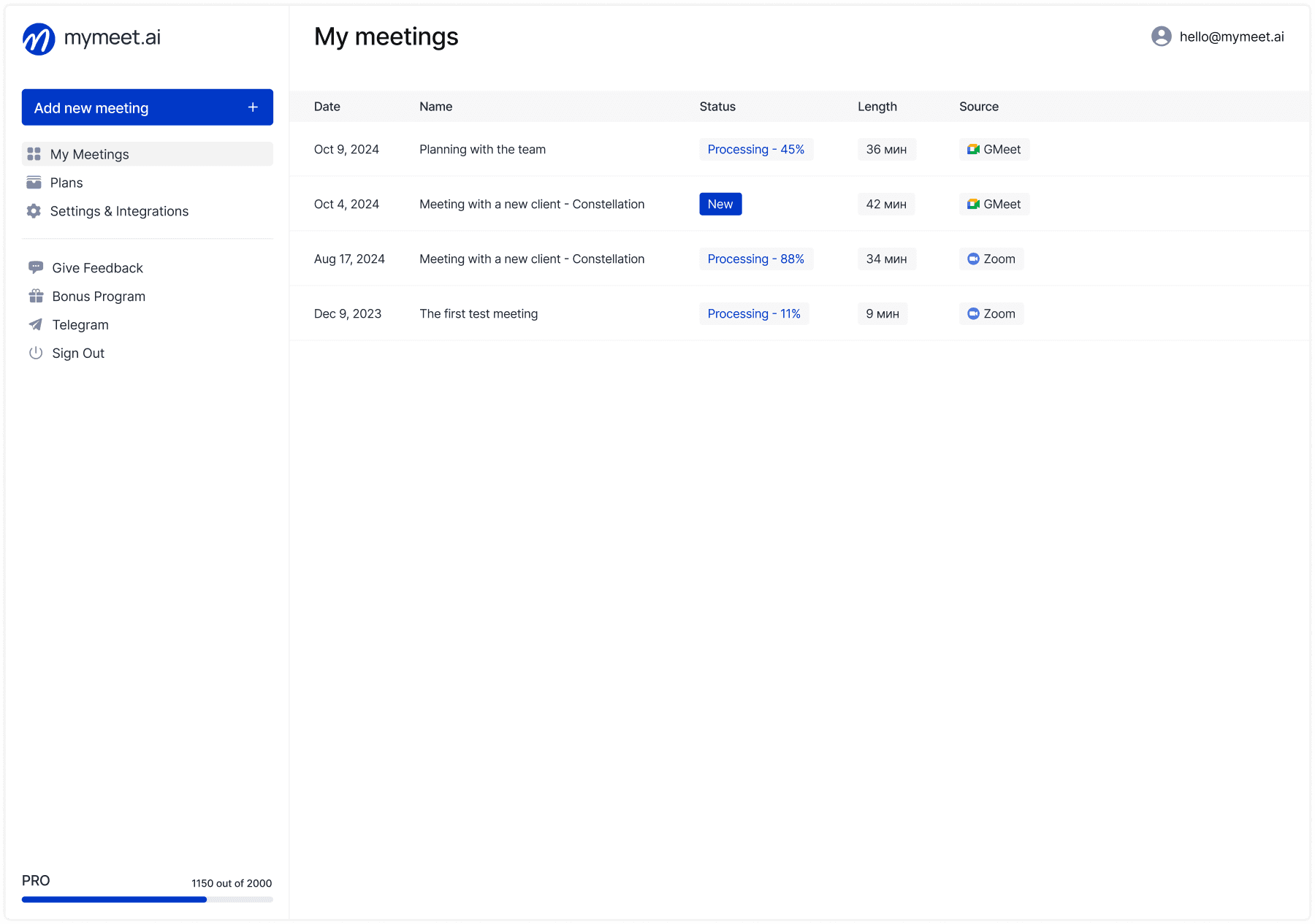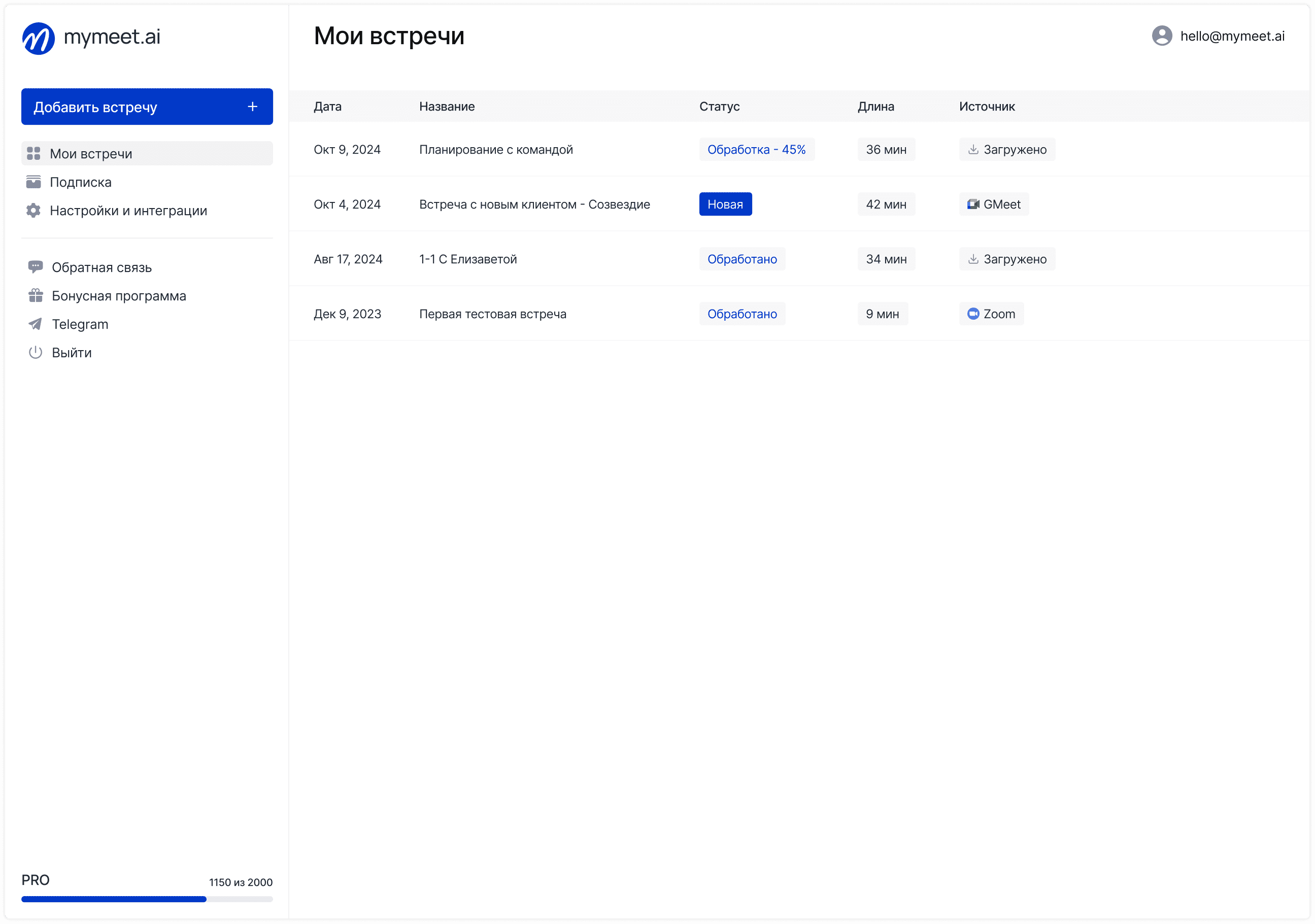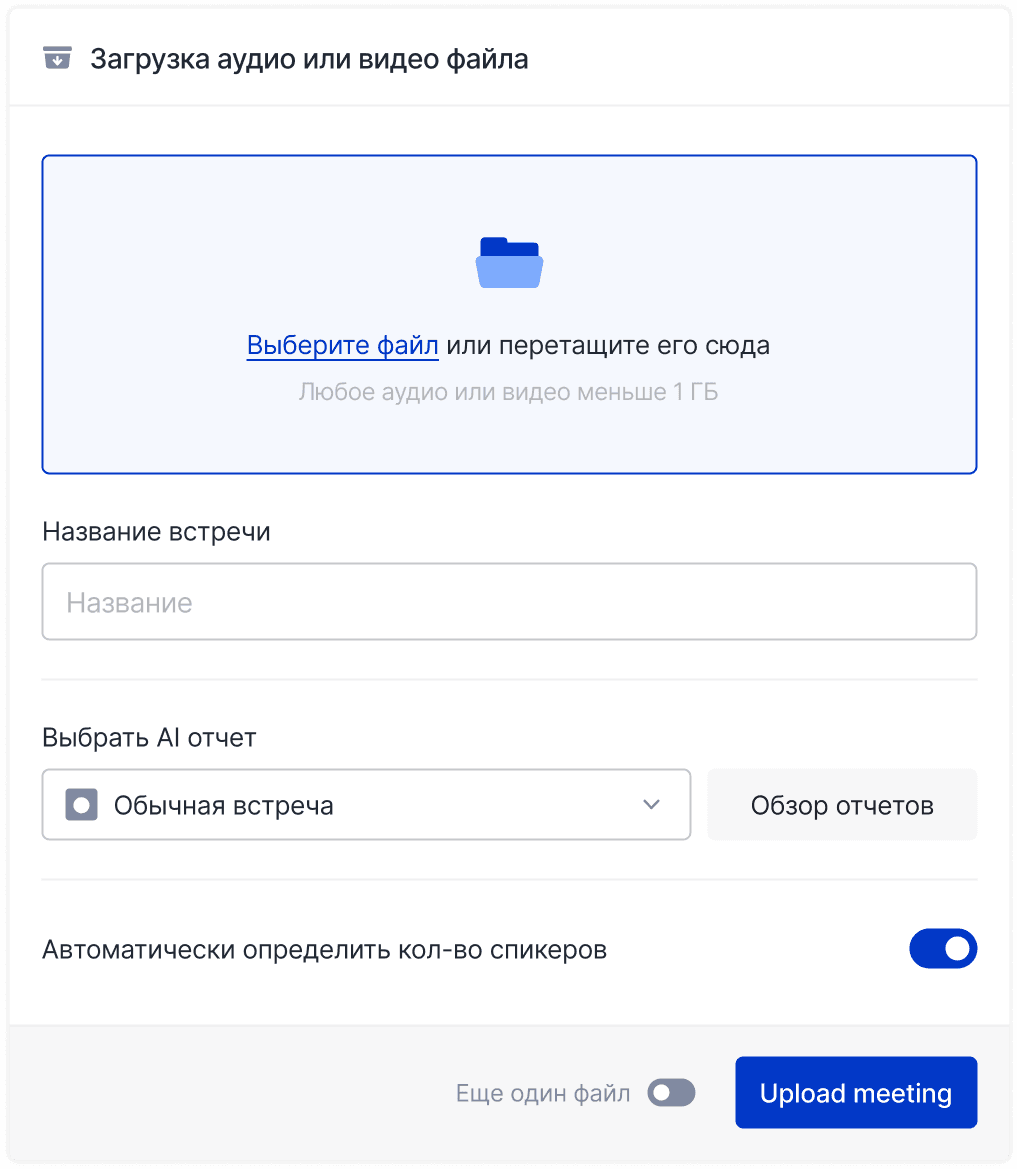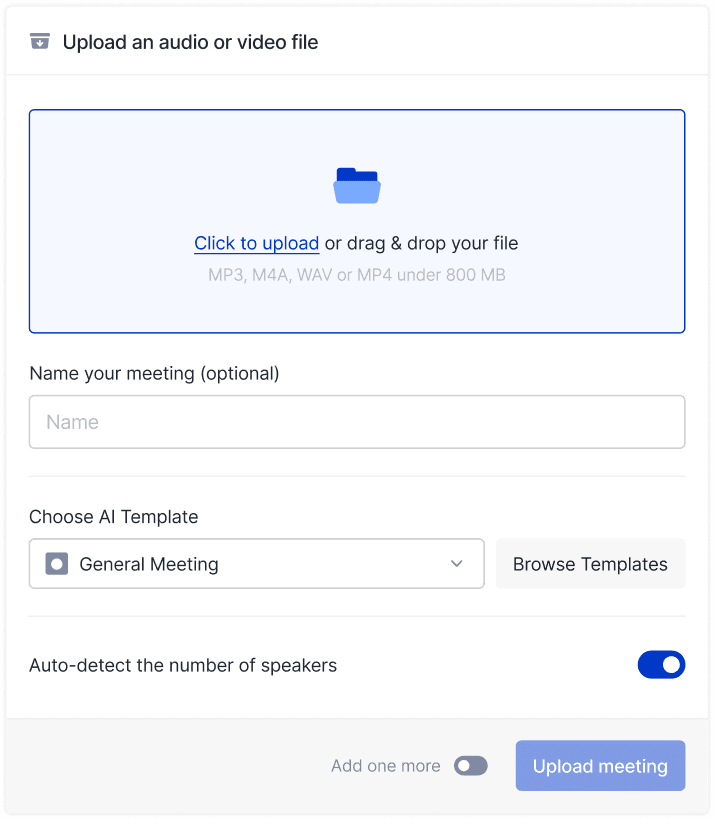Task Management

Ilya Berdysh
Jul 8, 2025
The IT director of a major logistics company conducted an experiment—recording all meetings for a month and calculating how much time was spent creating protocols. The result was shocking: 127 hours of pure employee time went to transcription and meeting documentation. Implementing speech recognition technologies reduced these costs to 8 hours per month, freeing up an entire full-time position for strategic tasks.
Paper protocols and manual note-taking are no longer relevant. Companies worldwide are massively transitioning to AI assistants that instantly transform hours of conversations into structured reports. From transcribing client calls to creating detailed meeting reports—artificial intelligence takes on routine tasks, allowing employees to focus on decision-making and business development.
How Speech Recognition Works in Business
Speech recognition technologies represent a complex of artificial intelligence algorithms capable of converting spoken speech into text format with high accuracy. Modern systems use deep machine learning to understand context, distinguish speakers, and adapt to pronunciation features.
Speech Recognition System Operating Principles
The speech recognition process consists of several audio signal processing stages. Acoustic models analyze sound waves, extracting phonemes and syllables. Language models use contextual information to interpret homonyms and complex constructions. Neural networks train on millions of hours of recordings, improving recognition quality.
Modern algorithms process speech in real-time, opening possibilities for interactive interaction. Systems account for background noise, multiple speakers, and recording equipment features. Machine learning adapts to specific terminology of various business industries.
Key Advantages for Business
Implementing speech recognition technologies brings companies measurable resource savings and qualitative business process improvements. Transcription automation frees employee time for analytical and creative tasks, while managers gain ability to quickly find needed information in meeting and negotiation archives.
Main business advantages:
Save 70-80% of time on protocol and report creation
Increase documentation accuracy to 95-98%
Standardize meeting and call analysis processes
Improve customer service quality control
Create searchable knowledge bases from voice data
Customer service quality significantly improves through automatic call analysis. Companies can identify communication problem points, track sales script compliance, and form knowledge bases based on real customer dialogues. Sales department managers receive detailed analytics on each manager's effectiveness.
Companies must consider data protection requirements when choosing solutions. Localized systems ensure legislation compliance and guarantee confidential information doesn't leave secure environments. Technical support in native languages accelerates issue resolution and simplifies personnel training.
Speech Recognition Applications by Industry
The spectrum of speech recognition technology applications in corporate environments constantly expands. Companies find new ways to use voice data for business process optimization, customer service improvement, and team efficiency enhancement.
Sales and Customer Service Automation

Sales departments receive powerful tools for analyzing manager effectiveness. Automatic call transcription allows managers to evaluate presentation quality, sales technique compliance, and identify growth points. Systems highlight key moments: customer objections, successful arguments, and deal breakdown reasons.
Knowledge base creation happens automatically based on successful dialogues. Companies form best practice libraries for quick new employee adaptation. Sentiment analysis helps identify dissatisfied customers at early stages.
Quality control becomes objective and comprehensive. Systems analyze 100% of calls, identifying regulation violations and service improvement opportunities.
Personnel Management and HR Processes

HR departments automate interview processes. Systems create detailed candidate reports, highlighting competencies, motivation, and corporate culture fit. Recruiters save time on note-taking and focus on potential evaluation.
Training programs become more effective through automatic lecture and training summary creation. Employees receive structured materials, and trainers analyze problematic topics.
Corporate culture monitoring happens through internal communication analysis. HR specialists identify conflicts, evaluate employee engagement, and track organizational change effectiveness.
Research and Analytics

Marketing research gains new possibilities through interview and focus group processing automation. Analysts process tens of times more data, identifying hidden consumer behavior patterns.
Analytical report creation accelerates through automatic information structuring. Researchers receive ready thematic blocks and key topic statistics.
Public opinion monitoring analyzes voice data from various sources: podcasts, radio programs, public events. Technologies help identify trends and adapt marketing strategies.
Types of Business Speech Recognition Systems
Choosing speech recognition system architecture depends on specific business needs, data security requirements, and company technical capabilities. Each approach has advantages and limitations that must be considered when planning implementation.
Solution Type Comparison
Solution Type | Advantages | Disadvantages | Suitable For |
Cloud | Quick start, auto-updates, scalability | Internet dependency, security questions | Small and medium business |
On-premise | Full data control, business customization | High investments, requires expertise | Large corporations, banks |
Hybrid | Balance of functions and security, flexibility | Management complexity | Growing companies |
Cloud Speech Recognition Platforms
Cloud solutions offer quick start without server infrastructure investments. Companies get access to modern algorithms constantly updated by developers. Scaling happens automatically depending on data volumes.
Corporate system integration occurs through APIs, allowing speech recognition function embedding in CRM, telephony systems, and video conferencing platforms. Developers use ready libraries for quick business application connections.
Limitations include internet connection dependency and data security questions. Companies must study provider policies regarding information storage, especially when working with customer personal data.
On-premise Speech Recognition Systems
On-premise solutions ensure full control over confidential information. Data doesn't leave corporate networks, critically important for banks, government organizations, and companies with sensitive information. Compliance with data protection requirements is achieved automatically.
Business-specific system customization happens more detailed. Companies train models on proprietary terminology, employee accents, and industry vocabulary. Recognition quality for specialized tasks often exceeds cloud solutions.
Infrastructure requirements include powerful servers, storage systems, and support expertise. Initial investments are higher than cloud solutions, but long-term costs are more predictable.
Hybrid Solutions
Hybrid architecture combines cloud and on-premise system advantages. Sensitive data processes locally, less critical information goes to the cloud for advanced capability use.
Scaling allows starting with cloud solutions and gradually moving critical processes to local infrastructure. This approach reduces initial risks and investments.
Hybrid system management requires complex architecture and additional IT team expertise. Companies must ensure data synchronization and maintain unified security standards.
Speech Recognition Solution Selection Criteria
Deciding on specific speech recognition system implementation requires comprehensive analysis of technical, functional, and economic factors. Companies must evaluate not only current needs but also long-term business development plans. Correct system choice determines entire automation project success and affects long-term investment efficiency.
Key system selection factors:
Speech recognition accuracy and industry terminology support
Data processing speed and real-time capabilities
Security level and data protection compliance
Integration quality with existing corporate systems
Pricing model and total cost of ownership
Technical support quality and team training
System Technical Characteristics
Speech recognition quality is a critical factor for companies. Systems must correctly process pronunciation features, understand context, and handle industry terminology. Multi-language support is important for international companies.
Data processing speed affects workflow efficiency. Modern systems transcribe hour-long recordings in 3-5 minutes, providing practically instant results. Real-time processing support opens possibilities for interactive applications.
Various audio file format compatibility ensures usage flexibility. Quality solutions support popular formats, adapt to different sound quality, and work with recordings from various sources: phone calls, video conferences, recorders.
Functional Capabilities
Emotion and sentiment analysis adds an additional understanding layer to transcription. Systems determine participant mood, stress levels, or customer satisfaction. Such information is especially valuable for sales and customer service departments.
Automatic keyword and topic highlighting helps quickly find needed information in large data volumes. Users can search specific discussion topics, product mentions, or customer names. Intelligent categorization simplifies reporting and analytics creation.
Integration capabilities with existing business processes determine how organically new technology fits into workflows. Best systems offer ready connections to popular CRM, video conferencing platforms, and corporate messengers.
Economic Factors
Pricing models differ between providers and significantly affect total ownership cost. Subscription models offer predictable expenses, per-minute payment is more cost-effective for irregular use. Important to consider hidden costs: limit overages, additional features, technical support.
Total cost of ownership includes initial investments, operational expenses, personnel training, and integration. On-premise solutions require significant initial investments but are more economical long-term for large companies.
Return on investment calculation considers employee time savings, process quality improvement, and new business opportunities. Many companies recoup investments in 6-12 months through routine task automation.
mymeet.ai: Leading Solution for Speech Automation

The mymeet.ai platform represents a comprehensive solution for voice information automation, created specifically for the global market. The system combines advanced artificial intelligence technologies with deep understanding of business specifics and regulatory requirements.

Key mymeet.ai Platform Capabilities
Companies receive powerful tools that transform voice data work approaches. Each platform function is developed considering real business needs and corporate process features.
Main mymeet.ai advantages:
✅ High-precision transcription in 73 languages with perfect speech processing and complex terminology understanding
✅ AI meeting analysis with smart insights — automatic structured report creation, task highlighting, and key decision identification

✅ Seamless integrations with popular platforms: Zoom, Google Meet, Microsoft Teams, and CRM systems
✅ Telegram bot with full functionality for instant access to all capabilities directly from messenger
✅ Specialized AI reports for various business spheres and meeting types
✅ Robust data protection — compliance with international standards and secure processing
✅ Expert support with understanding of business realities

✅ 180 minutes of free testing without card binding and hidden conditions
Processing speed impresses with efficiency—hour-long recordings become detailed reports in just 5 minutes. This means immediately after important meeting completion, you have ready structured information for decision-making.
mymeet.ai Industry Solutions
The platform offers 11 specialized AI reports, each tailored for specific business tasks and industry specifics:
Complete AI report lineup:
Client meeting — sales presentation analysis, objection identification, and successful closing technique detection
HR interview — structured candidate evaluation with competency highlighting and cultural fit assessment
Sales coach — manager call analysis with sales technique improvement recommendations
Meeting protocol — formal decision documentation, tasks, and responsibilities with deadlines
Research — interview processing with automatic insight extraction and feedback categorization
Team sync — workflow synchronization with project status and blocker documentation
Article — converting video and audio content into ready publication texts
One-on-one — structuring personal meetings between managers and subordinates
Medical — documenting medical consultations with symptom and recommendation highlighting
Summary — creating educational materials from lectures, webinars, and training
General meeting — universal analysis of any meetings with key moment highlighting
Each report uses specialized algorithms that understand context and highlight information critically important for specific spheres. "Research" report automatically structures respondent feedback, highlighting positive and negative moments, while "HR interview" creates detailed candidate profiles with competency evaluation.
Business Market Advantages
The platform is created with an understanding of unique business challenges. Data protection compliance is ensured through secure processing—your confidential information remains protected according to international standards. This is critically important for banks, government organizations, and companies working with sensitive data.
Technical support works not just in multiple languages but with a deep understanding of business processes and corporate culture. Expert teams help not only solve technical issues but optimize platform use for your business specifics.
Train employees to work with the AI assistant. Submit an application via the form for a corporate webinar.

Speech Recognition Technology Implementation
Successful speech recognition technology implementation requires systematic approach and phased realization. Companies that plan implementation processes in advance achieve better results and faster investment recoup.
Planning and Preparation Stages
Current process analysis helps identify most promising technology application points. Teams should document time spent on transcription, report creation, and information search in meeting recordings. Existing process audits show automation potential.
Goal definition and measurable efficiency indicators create the foundation for project success evaluation. Metrics include employee time savings, report quality improvement, decision-making acceleration. Clear KPIs help teams focus on achieving specific results.
Pilot project selection allows testing technology in controlled conditions with minimal risks. Recommended to start with easily measurable processes not critical for main company activities.
Technical Implementation
Integration setup with existing corporate systems requires coordination between the IT department and business users. Technical specialists must ensure reliable connection to CRM, telephony systems, and video conferencing platforms.
Team training includes mastering platform technical capabilities and forming new work habits. Employees must understand how to use automatically generated reports and integrate new tools into daily processes.
System quality testing is conducted on real data with gradual load increase. Team checks transcription accuracy, report quality, and integration stability.
Scaling and Development
Phased expansion to other processes and departments is based on pilot project experience. First stage lessons help avoid mistakes when implementing in new areas.
Continuous result analysis and technology use optimization ensure maximum investment return. Teams regularly review system settings and adapt processes to changing business needs.
Long-term strategy planning includes team competency development, functionality expansion, and new system integration. Companies considering speech recognition technologies as strategic assets gain competitive advantages.
ROI Measurement from Speech Recognition
Objective evaluation of speech recognition technology implementation results helps companies make informed decisions about system development and optimization. Properly chosen metrics demonstrate real investment value.
Key Efficiency Metrics
Objective implementation result evaluation requires establishing clear and measurable indicators. Companies should track both quantitative metrics (time, costs, volumes) and qualitative teamwork changes. Properly chosen KPIs help prove investment value and identify areas for further optimization.
Main measurement metrics:
Employee time savings on report creation and information search
Documentation accuracy and completeness improvement
Decision-making and problem response process acceleration
Customer service and satisfaction indicator improvement
Team productivity and analytics quality growth
Employee time savings are measured by comparing costs before and after automation implementation. Typical savings amount to 70-80% of time previously spent on manual transcription and report creation. Released resources can be directed to analytical tasks, customer work, or strategic planning.
Process quality improvement manifests in more accurate and complete reports, error reduction, and decision-making acceleration. Automatic systems ensure standardized documentation approaches and eliminate human factors in information processing.
Financial ROI Indicators
Automation cost comparison with manual work shows direct operational expense savings. Processing cost for one audio hour decreases 5-10 times compared to manual transcription. Additional savings achieved through reduced administrative personnel needs.
Sales and conversion impact manifests through manager work quality improvement, faster customer need identification, and sales process optimization. Companies note 15-25% conversion growth thanks to negotiation analysis insights.
Investment payback period for most companies is 6-12 months. Factors affecting playback speed: processed information volumes, employee time costs, implementation complexity, and process automation degree.
Speech Recognition Development Trends in Business
Artificial intelligence technology development opens new possibilities for business speech recognition applications. Companies following trends and preparing for changes gain first-mover advantages.
Technological Innovations
Neural network development leads to dramatic speech processing quality and speed improvement. New model architectures provide more accurate context understanding, better speaker distinction, and ability to work with low-quality audio recordings. Real-time processing becomes standard for corporate solutions.
Multimodal solutions combine speech, text, and video analysis for more complete communication understanding. Systems can analyze non-verbal signals, emotional reactions, and synchronize various information sources. This approach is especially valuable for presentation and negotiation analysis.
Personalization and adaptation to individual speech features improve recognition accuracy for specific users. Systems learn individual employee speaking patterns, adapt to company-specific terminology, and consider different department features.
Market Changes
Automation demand growth accelerates under digital transformation influence and efficiency improvement necessity. Companies seek ways to reduce operational expenses and improve process quality. Speech recognition technologies become standard tools for modern business.
Technology development receives additional impulse within digital advancement programs. Local developers create solutions specially adapted for market features and regulatory requirements. New business models based on voice data analysis emerge.
Remote work stimulates demand for effective online communication tools. Companies need solutions for virtual meeting documentation automation, remote team efficiency analysis, and corporate culture maintenance in distributed work conditions.
Conclusion
Speech recognition technologies open new possibilities for business automation and efficiency improvement. Companies implementing these solutions today gain competitive advantages and prepare for future digital economy challenges.
Successful implementation requires a systematic approach: from thorough needs analysis to phased realization with result measurement. Solutions like mymeet.ai offer optimal combination of functionality, security, and local requirement compliance.
Start digital transformation today: test meeting automation capabilities with mymeet.ai. 180 minutes of free testing without card binding will help evaluate technology potential for your business.
FAQ About Speech Recognition
What speech recognition accuracy do modern systems provide?
Quality systems ensure 95-98% speech recognition accuracy for good quality recordings. Accuracy depends on audio quality, background noise amount, and speaker pronunciation features.
Can technologies be used for confidential negotiations?
Yes, when using on-premise or hybrid solutions that process data within company territory. Such systems ensure data protection compliance and full control over confidential information.
How much time does speech recognition system implementation require?
Cloud solutions can be launched in 1-2 weeks. On-premise systems require 1-3 months for implementation depending on integration complexity and team training.
What audio file formats do systems support?
Modern systems work with main formats: MP3, WAV, M4A, FLAC, OGG. Quality solutions automatically convert files and optimize them for processing.
How is data protection ensured in cloud solutions?
Providers use data encryption, certified data centers, and comply with international security standards. For critical data, on-premise solutions are recommended.
Can speech recognition be integrated with CRM systems?
Yes, most modern platforms offer ready integrations with popular CRM systems through APIs. Integration allows automatic call and meeting record creation.
Which industries benefit most from technologies?
Maximum effect is achieved in sales, customer service, HR, research, and consulting—wherever processing large volumes of conversational information is important.
Is special employee training needed for work?
Modern systems are intuitively understandable. Basic training takes 1-2 hours. Advanced functions may require additional 1-2 day training.
How to calculate ROI from speech technology implementation?
ROI is calculated through employee time savings, process quality improvement, and sales growth. Typical payback is 6-12 months with 70-80% documentation time savings.
What free alternatives exist for small businesses?
Many providers offer free plans with volume limitations. For example, mymeet.ai provides 180 minutes of free testing without card binding for platform capability familiarization.
Ilya Berdysh
Jul 8, 2025







